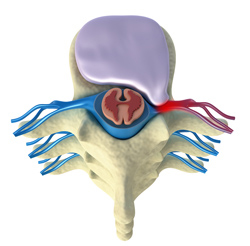
Treating a Prolapsed Disc & Sciatica
The disc is made from a jelly-like centre (nucleus pulposus) surrounded by a hard outer ring (annulus fibrosis). The jelly-like center can push against the outer ring. This may initially cause a bulging of the outer ring of the disc, called a bulging disc. However if there is enough force or if the outer annulus is very worn or damaged, the nucleus may squeeze all the way through. This is called a prolapsed or herniated disc. It often occurs with lifting, pulling, bending, or twisting movements.
Patients with this condition may experience a sudden onset of back pain during the causative activity, however, it is also common for patients to experience pain and stiffness after the provocative activity, particularly the next morning.
Symptoms are typically felt in the lower back and may be located centrally, on one side or on both sides of the spine.
If the prolapsed disk bulges out toward the spinal canal, it can put pressure on the sensitive spinal nerves. This can cause pain that radiates down the leg (sciatica), pins and needles, numbness, shooting pains, and can cause muscle weakness. Sciatica is not a diagnosis, but rather a description of symptoms.
Sciatic nerve
There are a number of conditions which can cause compression or irritation to the sciatic nerve resulting in sciatic pain. For example:
- Lumbar disc bulge/herniation/prolapse
- Spondylolisthesis
- Pirformis Syndrome
- Sacroiliac Joint Dysfunction
- Degeneratice Disc Desease
- Spinal Canal Stenosis
- Bony growths (osteophytes)
Other less common conditions which may also cause sciatic pain include:
- Tumours
- Infections
Treatment for a Prolapsed Disc and Sciatica
Physiotherapy treatment for patients with this condition is vital to hasten the healing process, ensure an optimal outcome and decrease the likelihood of injury recurrence. Treatment may comprise:
- Joint mobilisation
- Joint manipulation
- Spinal and pelvic realignment
- Dry needling /acupuncture
- Deep tissue massage/myofascial release
- Ultrasound/electrotherapy
- Exercise programs to stretch, self treat and improve proprioception, balance, strength and core stability
- Biomechanical Assessment
- Neural mobilisation
- Education / training advise/ phased return to exercise
- Activity modification advice
- Orthotic/Insole advise
- Ice or heat treatment
- Taping
- Clinical Pilates
- Injection advise
